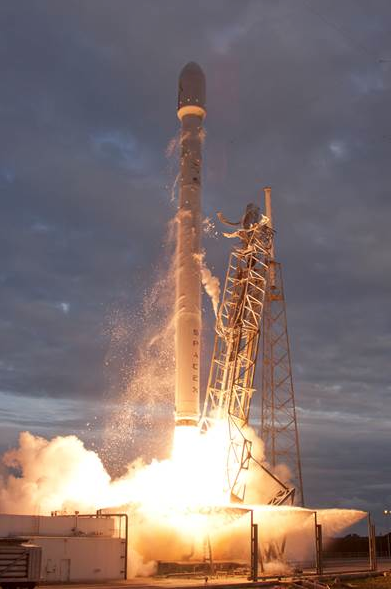
Photo courtesy of SpaceX January 6, 2014
[SatNews] The launch was successful...next comes the the delivery of all that payload power.
Statement from SpaceX
Cape Canaveral Air Force Station, Florida – Today, Space Exploration Technologies (SpaceX) successfully launched the THAICOM 6 satellite for leading Asian satellite operator THAICOM. Falcon 9 delivered THAICOM 6 to its targeted 295 x 90,000 km geosynchronous transfer orbit at 22.5 degrees inclination. The Falcon 9 launch vehicle performed as expected, meeting 100 percent of mission objectives.
Falcon 9 lifted off from Space Launch Complex 40 (SLC-40) at 5:06 PM Eastern Time. Approximately 184 seconds into flight, Falcon 9’s second-stage Merlin vacuum engine ignited to begin a five minute, 35 second burn that delivered the THAICOM 6 satellite into its parking orbit. Eighteen minutes after injection into the parking orbit, the second stage engine relit for just over one minute to carry the THAICOM 6 satellite to its final geostationary transfer orbit. The restart of the Falcon 9 second stage is a requirement for all geostationary transfer missions.
“Today’s successful launch of the THAICOM 6 satellite marks the eighth successful flight in a row for Falcon 9,” said Gwynne Shotwell, President of SpaceX. “SpaceX greatly appreciates THAICOM’s support throughout this campaign and we look forward to a busy launch schedule in 2014.”
The THAICOM 6 mission marks Falcon 9’s second flight to a geosynchronous transfer orbit and begins a regular cadence of launches planned for SpaceX in 2014. SpaceX has nearly 50 launches on manifest, of which over 60% are for commercial customers.
This launch also marks the third of three qualification flights needed to certify the Falcon 9 to fly missions under the Evolved Expendable Launch Vehicle (EELV) program. Once Falcon 9 is certified, SpaceX will be eligible to compete to launch national security satellites for the U.S. Air Force.
End of SpaceX's statement
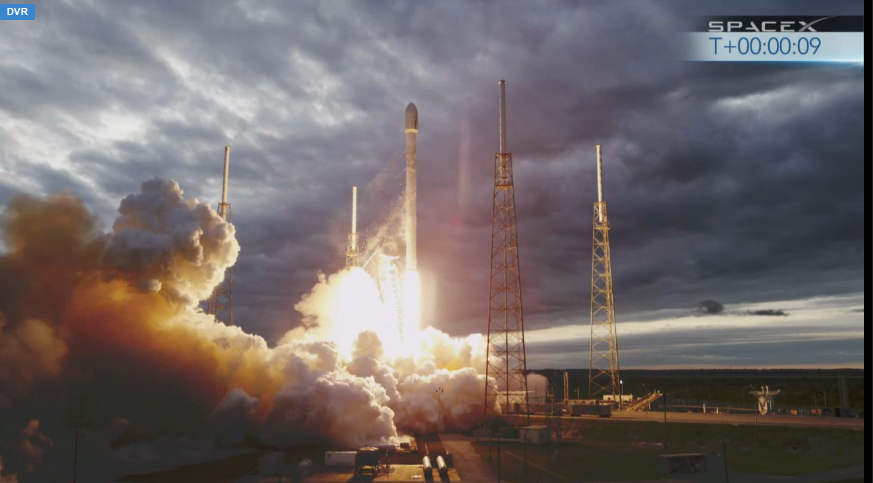 the reliable and safe transport of satellites and the Dragon spacecraft into orbit. As the first rocket completely developed in the 21st century, Falcon 9 was designed from the ground up for maximum reliability. Falcon 9’s simple two-stage configuration minimizes the number of separation events, and with nine first-stage engines, it can safely complete its mission even in the event of an engine shutdown.
the reliable and safe transport of satellites and the Dragon spacecraft into orbit. As the first rocket completely developed in the 21st century, Falcon 9 was designed from the ground up for maximum reliability. Falcon 9’s simple two-stage configuration minimizes the number of separation events, and with nine first-stage engines, it can safely complete its mission even in the event of an engine shutdown.Falcon 9 made history in 2012 when it delivered Dragon into the correct orbit for rendezvous with the International Space Station, making SpaceX the first commercial company ever to visit the station. Since then SpaceX has made a total of three flights to the space station, both delivering and returning cargo for NASA. Falcon 9, along with the Dragon spacecraft, was designed from the outset to deliver humans into space and under an agreement with NASA, SpaceX is actively working toward that goal.
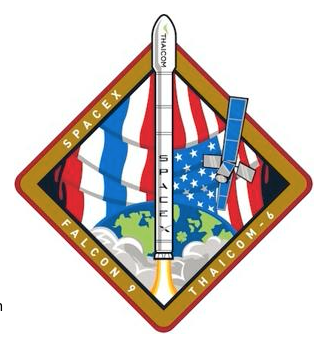
The Thaicom 6 Satellite design is based on Orbital's successful, flight-proven, GeoStar-2™satellite platform, and was manufactured and tested at Orbital's state-of-the-art manufacturing facility in Dulles, Virginia.
Thaicom 6 will be located at 78.5 degrees East Longitude, and carries a hybrid Ku- and C-band payload that will generate approximately 3.7 kilowatts of payload power. The Ku-band payload is comprised of eight active transponders that will provide services to Thailand, Laos, Cambodia, and Myanmar. The C-band payload features 12 active C-band transponders that will provide services via a regional beam to Southeast Asia, and six active C-band transponders that will provide services via a south Africa beam to southern Africa and Madagascar.
The THAICOM 6 mission will launch the THAICOM 6 commercial telecommunications satellite, an Orbital Sciences GEOStar-2 spacecraft. This hybrid Ku- and C-band spacecraft weighs 3,016 kg (6,649 lbs) at launch. This mission is the second Falcon 9 launch to a geosynchronous transfer orbit, targeting a 295 x 90,000 km orbit at 22.5 degrees inclination.
THAICOM 6 will be co-located with THAICOM 5 at 78.5 degrees East (“Hot Bird” position), and carry a hybrid Ku- and C-band
payload generating approximately 3.7 kilowatts of payload power. The Ku-band payload will be comprised of 8 active transponders providing services to the Southeast Asia (mainland). The C-band payload will feature 18 active C-band transponders providing services via the satellite’s regional beam to Southeast Asia and Africa, including
Madagascar.
All spaceflight is incredibly complicated. Every component of the mission must operate optimally. Hardware, avionics, sensors, software and communications must function together flawlessly. If any aspect of the mission is not successful, SpaceX will learn from the experience and try again.
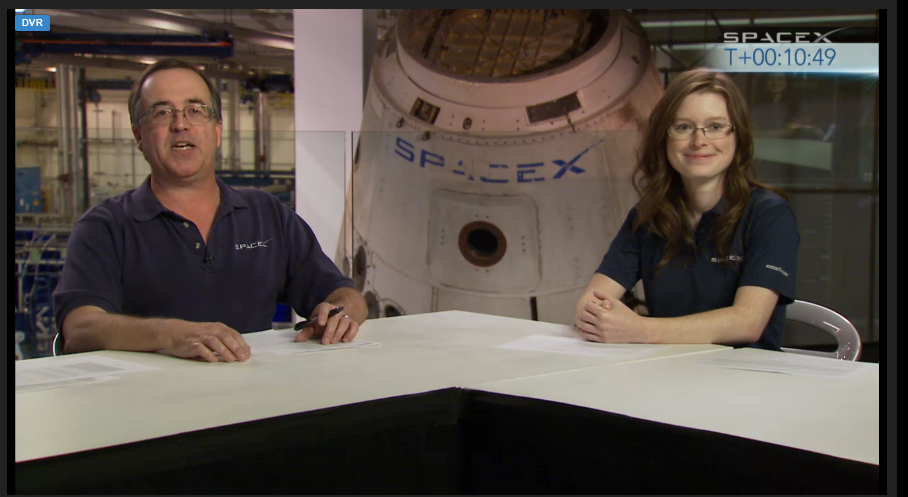
Mission accomplished, and everyone is happy.
Months before a Falcon 9 launch, both rocket stages are transported to SpaceX’s development facility in McGregor, Texas for testing, and then trucked individually to SpaceX’s hangar at Space Launch Complex 40 at the Cape Canaveral Air Force Station in Cape Canaveral, Florida. SpaceX’s payload fairing is shipped separately to the launch site. Around 30 days before launch, the spacecraft arrives at SpaceX’s SLC-40 hangar annex. In the days that follow, the spacecraft is processed and encapsulated within the fairing, and the rocket stages are integrated.
The final major preflight test is a static fire, when Falcon 9’s nine first-stage engines are ignited for a few seconds, with the vehicle held securely to the pad. One day prior to launch, Falcon 9 and its payload are transported to the launch pad and raised vertically. All ground personnel leave the pad in preparation for fueling of the launch vehicle.
The launch sequence for Falcon 9 is a process of precision necessitated by the rocket’s approximately one-hour launch window, dictated by the
desired orbit for the satellite. If the one-hour time window is missed, the mission will be attempted on the next available date.
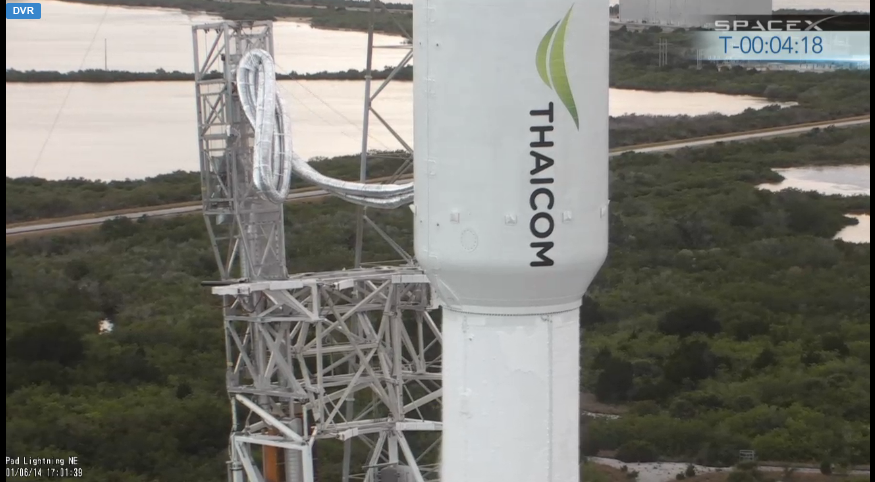
Strong back clamps retracting before last four minutes to lift off.
A little less than four hours before launch, the fueling process begins— liquid oxygen first, then RP-1 kerosene propellant. The plume coming
off the vehicle during countdown is gaseous oxygen being vented from the tanks, which is why the liquid oxygen is topped off throughout the
countdown.
Terminal countdown begins at T-10 minutes, at which point all systems are autonomous. The SpaceX Launch Director at the Cape Canaveral Air Force Station gives a final go for launch at T-2 minutes and 30 seconds. At T-2 minutes, the Air Force Range Control Officer confirms the
physical safety of the launch area and provides the final range status.
Just before liftoff, the launch pad’s water deluge system, dubbed “Niagara,” is activated. Seconds before launch, the nine Merlin engines of the first stage ignite. The rocket computer commands the launch mount to release the vehicle for flight, and at T-0 Falcon 9 lifts off, putting out 1.3 million pounds of thrust
The vehicle will pass through the area of maximum aerodynamic pressure—max Q—approximately 80 seconds into flight. This is the point when mechanical stress on the rocket peaks due to a combination of the rocket’s velocity and resistance created by the Earth’s atmosphere.
Approximately 174 seconds into flight, the first-stage engines are shut down, an event known as main-engine cutoff, or MECO. Three seconds after MECO, the first and second stages will separate. Seven seconds later, the second stage’s single Merlin vacuum engine ignites to begin a 5 minute, 35 second burn that brings the satellite into a parking orbit.
The fairing that protects the payload is deployed early in this burn. Eighteen minutes after injection into the parking orbit, the second stage will relight for just over one minute to carry the payload to its geosynchronous transfer orbit.
Approximately three minutes after the second burn (at the 31 minute, 13 second mark after launch), the THAICOM 6 satellite is deployed into orbit.

